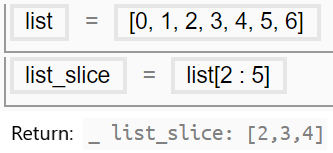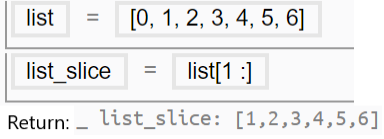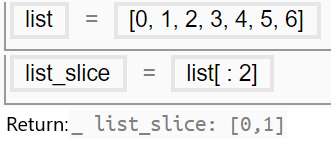List
A list can contain numbers, variables and strings.
Users with prior 3D modelling experience may see similarities between creating lists in Mobius and the Grouping function in direct modelling softwares. The strength of parametric modelling lies in the greater flexibility it offers when it comes to editing the list and manipulating the items in the list, such as joining lists, flattening lists in depth or making use of list indexing in conditional statements like For, hence allowing more efficient modelling.
Indexing
An index refers to a position within an ordered list. Each item in a list is given an index from zero (at the beginning) to the length minus one (at the end). Square brackets are used to denote lists as well as the index of a list.
For instance, in list=[1,5,3], list[0] = 1 because 1 is the 1st item in the list; list[2]=3 as 3 is the last item in the list.
| List | Index |
|---|---|
| List = [[0,1,2], [3,4,5], [6,7,8]] | List[1] = [3,4,5] |
| a = entity1 b = entity2 List = [a, b] |
List[0] = a = entity1 |
List Depth
The depth of a list is determined by the number of times by a sublist is nested inside of it.
A list with the depth of 1 is also known as a flat list, as it has no sublist nested in it.
| List | Depth of list |
|---|---|
| a = [0,1,2] | 1 |
| b = [1,2,3,[2,1]] | 2 |
| d = [1,2,3,[3,[2,1]],4] | 3 |
Order in a List
When using query.Get or any other functions with entity-sorting options, the list returned can be acquired in an ascending order, descending order or geometric order.
| Order | Description |
|---|---|
| Ascending | Data is in ascending order e.g “ps0”, “ps1”, “ps2” |
| Descending | Data is in descending order e.g “ps2”, “ps1”, “ps0” |
| Geometric | The sequence of obtaining the geometric data follows that of the entity e.g “ps1”, “ps2”, “ps3”. The sequence may or may not follow an ascending order, depending how the entity is constructed. |
When generating entities from a list of positions using functions like make.Loft and make.Polygon, the order of entities in the list is crucial in creating logical models. In fact, strange looking geometries may be generated when the list is not in geometric order. Therefore, when encountering such problems, users are advised to check through the order of entities.




